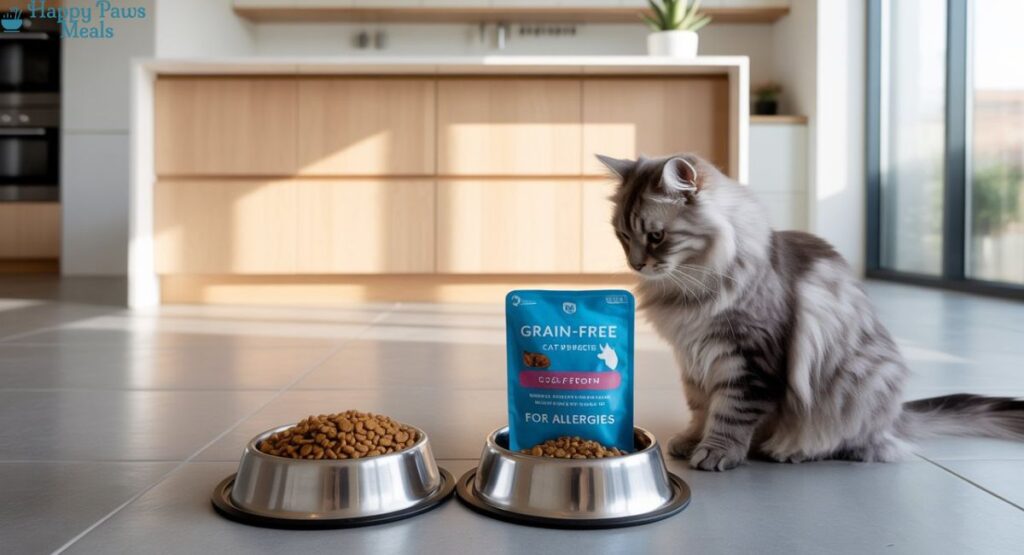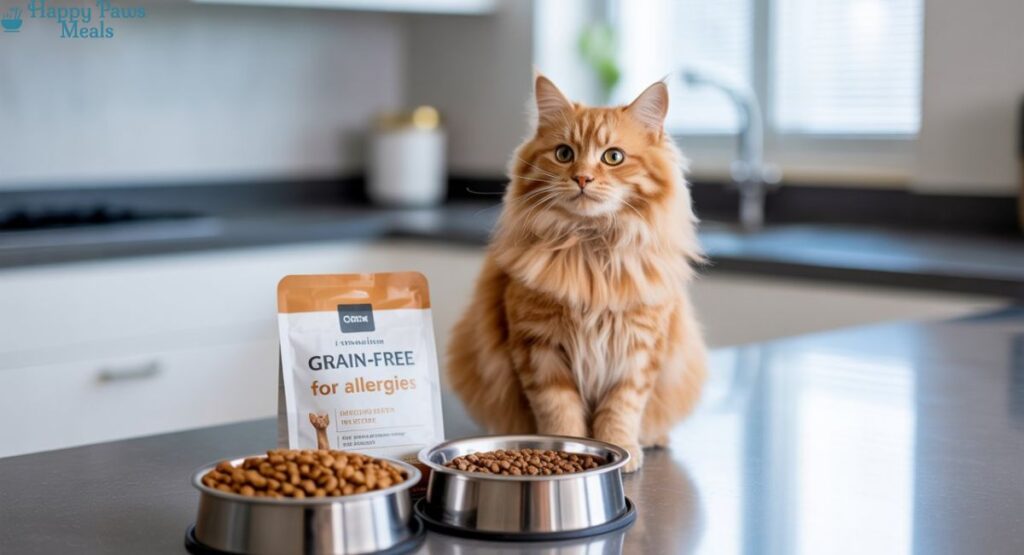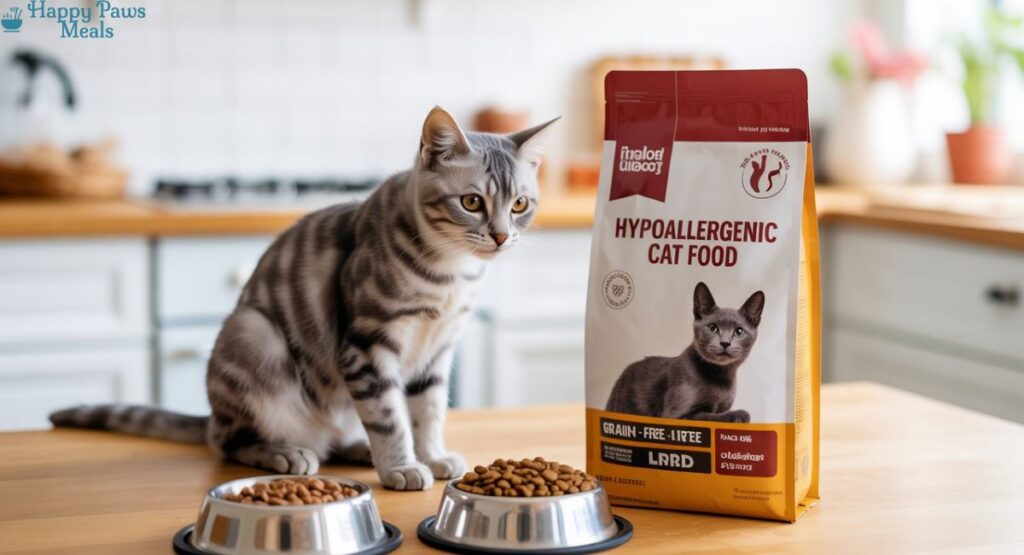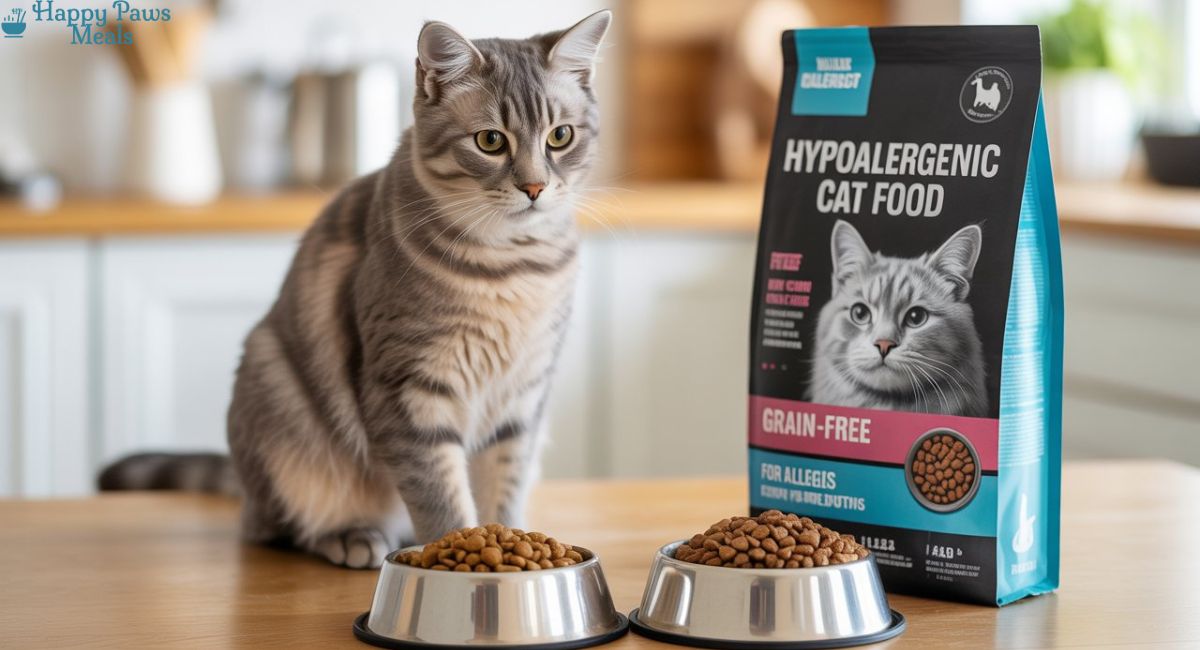Cats are beloved family members, but when food allergies strike, both pets and owners struggle. If your feline suffers from constant itching, digestive upsets, or chronic ear infections, the culprit might be hidden in their food bowl. That’s where the best hypoallergenic cat food for allergies comes in. When pet parents search for the best hypoallergenic cat food for allergies, they are usually looking for safe options that prevent skin irritation and digestive problems.
In 2026, pet nutrition is more advanced than ever. Pet parents now have access to grain-free, limited-ingredient, and vet-approved hypoallergenic formulas designed specifically to prevent allergic reactions. In this guide, we’ll explore what cat food allergies are, how to identify them, and the best hypoallergenic cat food for allergies that can keep your cat safe, happy, and healthy.
What Are Cat Food Allergies?
Cat food allergies occur when a cat’s immune system mistakenly identifies certain ingredients as harmful. The body reacts with inflammation, itching, or digestive problems. Unlike food intolerances (which only cause stomach upset), true allergies trigger the immune system. Veterinarians often recommend the best hypoallergenic cat food for allergies because it eliminates common triggers like chicken, beef, and grains.
Common Symptoms of Cat Food Allergies:
- Chronic itching or scratching
- Red, inflamed skin
- Vomiting or diarrhea
- Hair loss or bald patches
- Chronic ear infections
- Swelling of lips, face, or eyelids
If your cat shows these signs, your vet may recommend switching to hypoallergenic cat food to prevent flare-ups.
What Makes Food Hypoallergenic?
The term “hypoallergenic” means the food is less likely to cause an allergic reaction. Choosing the best hypoallergenic cat food for allergies means focusing on simple, clean ingredients that your cat’s body can tolerate without reacting.

The best hypoallergenic cat food for allergies often includes:
- Novel Proteins – Proteins cats haven’t been exposed to before, like duck, rabbit, or venison.
- Hydrolyzed Proteins – Proteins broken down into smaller parts so the immune system doesn’t recognize them as allergens.
- Limited Ingredient Diets (LID) – Fewer ingredients reduce the risk of triggering allergies.
- Grain-Free Options – Many cats are sensitive to corn, wheat, or soy.
The Best Hypoallergenic Cat Food for Allergies in 2026
Brands like Royal Canin, Hill’s, and Blue Buffalo are often ranked among the best hypoallergenic cat food for allergies because they use hydrolyzed or novel proteins. Below are top picks for 2026, chosen based on veterinary recommendations, customer reviews, and nutritional value.
1. Royal Canin Veterinary Diet Hydrolyzed Protein
- Uses hydrolyzed soy protein, reducing allergenic risk.
- Supports skin and digestive health.
- Often prescribed by vets for severe allergies.
2. Hill’s Prescription Diet z/d Skin/Food Sensitivities
- Hydrolyzed chicken liver protein.
- Clinically proven to reduce skin and digestive signs of food sensitivities.
- Highly digestible formula.
3. Blue Buffalo Basics Limited Ingredient Grain-Free Cat Food
- Uses novel proteins like turkey or duck.
- Contains pumpkin and peas for gentle digestion.
- Free from chicken, beef, dairy, and eggs—common allergens.
4. Instinct Limited Ingredient Diet Grain-Free Cat Food
- Single animal protein (rabbit, turkey, or lamb).
- Free from grains, dairy, eggs, and artificial preservatives.
- Designed for sensitive stomachs.
5. Purina Pro Plan Veterinary Diets HA Hydrolyzed Formula
- 100% hydrolyzed soy protein.
- Balanced for long-term feeding.
- Recommended for cats with multiple allergies.
Homemade vs Store-Bought Hypoallergenic Cat Food
Some pet parents prefer homemade cat food, believing it’s safer. Many pet owners wonder if homemade meals can replace the best hypoallergenic cat food for allergies, but balancing nutrients at home can be difficult. However, it’s easy to create unbalanced meals. Store-bought hypoallergenic cat food ensures proper nutrition, but homemade diets should always be formulated with veterinary guidance.

Transitioning Your Cat to Hypoallergenic Food
Switching to the best hypoallergenic cat food for allergies should always be gradual, giving your cat’s stomach time to adjust. Switching cat food must be done gradually to prevent stomach upset.
Step-by-step transition:
- Days 1–3: Mix about 25% of the new hypoallergenic food with 75% of your cat’s old food. This small change helps your cat get used to the new flavor without stress.
- Days 4–6: Increase to 50% new food and 50% old food. By now, your cat is more familiar with the new taste and texture.
- Days 7–9: Move to 75% new food and 25% old food. At this stage, most cats start accepting the new diet fully.
- Day 10 onward: Feed 100% of the new hypoallergenic cat food. Your cat’s body will now be adapted, and you can enjoy the benefits of reduced allergies and improved digestion.
👉 Pro tip: Always monitor your cat during this process. If you notice vomiting, diarrhea, or refusal to eat, slow down the transition by extending each stage a few more days. If you’re considering switching your pet’s diet, you may also want to read our guide on Homemade Cat Food vs Store-Bought: Pros & Cons for more insights into balanced nutrition.
Feeding Tips for Cats with Allergies
To see results faster, stick only to the best hypoallergenic cat food for allergies and avoid mixing with treats or table scraps.
- Always provide fresh water.
- Avoid treats with unknown proteins.
- Stick to one protein source.
- Follow feeding hours consistently.
(Internal Link suggestion: [Feeding Hours for Cats])
Is Hypoallergenic Cat Food Safe for All Cats?
Yes, but it’s not always necessary. Cats without allergies may not need such specialized diets. However, for allergic cats, the best hypoallergenic cat food for allergies can be life-changing. Even if your cat doesn’t show symptoms, the best hypoallergenic cat food for allergies can still support healthier skin and digestion.

When choosing the best hypoallergenic cat food for allergies, it’s important to make sure the recipe still provides complete and balanced nutrition. Most trusted brands follow the official [AAFCO Cat Food Nutrient Standards], which set the minimum requirements for essential vitamins, minerals, and protein that keep your cat healthy.
Frequently Asked Questions
How long does it take to see improvement after switching to hypoallergenic cat food?
Usually 6–8 weeks. Skin and coat health may take longer to recover.
Can grain-free cat food cure allergies?
Not always. While grains cause issues for some cats, protein sources are the most common allergens.
Do kittens need hypoallergenic food?
Only if they show allergic symptoms. Otherwise, feed kitten-specific formulas.
What is the best hypoallergenic cat food for allergies in 2026?
Vet-approved options like Royal Canin Hydrolyzed Protein and Hill’s z/d are top choices.
Conclusion
Choosing the best hypoallergenic cat food for allergies in 2026 is one of the most important steps in managing your cat’s health. By understanding food allergies, identifying triggers, and working with your vet, you can help your cat live a longer, itch-free life. If your cat struggles with itching, vomiting, or diarrhea, the best hypoallergenic cat food for allergies may be the key to long-term relief.
Whether you choose hydrolyzed formulas, limited-ingredient diets, or grain-free alternatives, always prioritize quality and veterinary guidance. With the right food, your feline friend can thrive without the discomfort of allergies.

I’m Awais Manzoor, the writer behind HappyPawsMeals. With years of interest in pet care and nutrition, I research and review cat and dog food to provide reliable, easy-to-understand advice for pet parents.

